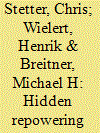| Srl | Item |
| 1 |
ID:
186442


|
|
|
|
|
| Summary/Abstract |
Feed-in tariff funding will cease by 2025 for more than 70% of the currently installed onshore wind turbines in Germany. For many wind turbines, the feasibility of repowering from a regulatory point of view is unknown; that is, a complete replacement of the old wind turbines with new, modern, and more efficient models. In Germany, restrictive regulations regarding the required minimum distances of wind turbines from residential and other protected areas may impede repowering, thereby rendering a site non-repowerable. Many of these wind turbine sites are well-established in terms of their acceptance by the local population. Our analysis shows that the potential of non-repowerable but well-established locations with more efficient technology at the same height is almost twice that of the sites qualified for repowering via higher wind turbines. The latest legislation of the German federal government prescribes minimum distances of 1,000 m between a wind turbine and the nearest residential buildings. This will slow down the expansion of onshore wind energy in Germany and decrease its contribution to climate neutrality. This study quantifies the nationwide effects of restrictive legislative minimum distance regulations on repowering potential by means of a developed geographic information system that utilizes highly detailed settlement structures.
|
|
|
|
|
|
|
|
|
|
|
|
|
|
|
|
| 2 |
ID:
177452


|
|
|
|
|
| Summary/Abstract |
Legitimacy is a key function within Technological Innovation Systems (TIS), influencing the development and diffusion of novel technologies such as onshore wind energy. By combining insights from TIS and from organization studies, we provide theoretical and empirical underpinnings to ‘legitimacy’, a concept often defined superficially and mapped at an aggregate, national level. We add a spatial perspective by comparing dimensions of legitimacy between two heterogenous regions in Germany. They have similar diffusion trajectories of wind energy but differ in structural features (socio-economic factors and TIS elements). To capture place-specific institutions and dynamics influencing regional legitimacy, we focus on decision makers and their perception of the TIS. Even though politicians and civil servants are crucial for wind development in their constituent regions and are thus important contextual actors to the TIS, their perspective has been mostly neglected. Applying a comprehensive, mixed methods approach, we conducted an online survey among these decision makers and complemented the insights with qualitative expert interviews. Our analysis shows that pragmatic and moral dimensions of legitimacy are particularly susceptible to place-specific influences. These spatially sensitive insights have been missing from the debate on legitimacy so far and might inform policy directed at advancing technological legitimacy in certain regions.
|
|
|
|
|
|
|
|
|
|
|
|
|
|
|
|